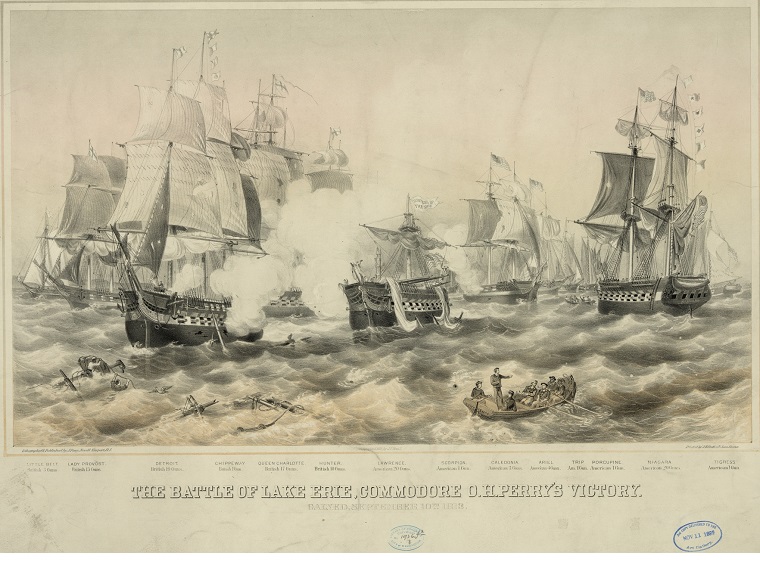Two hundred years ago today, on December 24, 1814, the Treaty of Ghent was signed, officially ending of the War of 1812. The War of 1812 between the U.S. and Britain was a minor part of the worldwide Napoleonic Wars.
Largely forgotten nowadays, fierce naval battles and a strange naval arms race took place on the remote wilderness waters of the Great Lakes. Each side raced to chop down trees and build larger and larger wooden men-of-war.
When the United States declared war on June 18, 1812, the U.S. Navy had only one small 16-gun brig on the Great Lakes. The Army had an even smaller 6-gun brig, which the British promptly captured. The British had no naval vessels on the Great Lakes, but did have about a dozen small armed transports.
The British quickly used their naval advantage and their alliances with the Native American tribes to seize most of the strategically significant places on the Great Lakes. Fort Mackinac, controlling the strait between Lakes Huron and Michigan, fell in July. Although the U.S. initially took Sandwich (now Windsor, Ont.), the British captured Detroit in August. Detroit controls the Detroit River connecting Lakes Huron and Erie. Fort Dearborn (Chicago), controlling the Lake Michigan to Mississippi River route, also fell in August.
Several minor naval battles on the Lakes during 1812 set the stage for a naval arms race. As Theodore Roosevelt points out in The Naval War of 1812, the Great Lakes were far from London and Washington, so accurate information about what actually happened is scarce. After meeting in battle, typically both sides would report that they had scored a victory over a much stronger force.
During the winter of 1812/13, the US Navy sent shipwrights and sailors to the obscure Lake Ontario town of Sacketts Harbor, NY. They proceeded to chop down trees and build ships. Other US ship-building bases included Presque Isle (now Erie, PA) on Lake Erie and Black Rock (near Buffalo, NY) on the Niagara River. The Niagara River flows from Lake Erie to Lake Ontario via Niagara Falls.
The British built ships in their bases of Kingston, Ont. and York (now Toronto.) When the ice broke up in the spring of 1813, each side had built more warships than the total owned by both sides a year earlier.
Aside from Commodore Oliver Hazard Perry’s decisive victory in the Battle of Lake Erie, most of the battles of the summer of 1813 were inconclusive. When winter came, both sides went back to building ships.
The 1814 fleets were again stronger than ever, both sides having built several large ships mounting over 50 heavy guns each. The Americans won another decisive victory on Lake Champlain (located between Vermont and New York), ending British plans to invade New York. In September, the British Launched the Saint Lawrence, a three-deck ship of the line, one of the largest ships of her day, mounting 112 guns, and carrying a crew of 800. This gave them control of Lake Ontario for the two months until freeze-up.
When peace came at the end of 1814, the naval arms race was just reaching its peak. Both sides had under construction multiple ships of the line capable of mounting as many as 120 guns each. The British were said to also be busy carrying several pre-fabricated frigates around Niagara Falls.
The naval arms race was not really over until the Rush-Bagot Pact of 1817. The Pact limited each side to one naval vessel on Lake Ontario plus a total of two on the other lakes. The vessels could not exceed 100 tons and could only carry one gun of 18 pounds (a muzzle loader shooting a five inch cannonball.)
To show the sort of folly the pact was trying to prevent, the HMS Saint Lawrence, launched in 1814, was rated at 2300 tons and had 112 guns ranging from 24-pounders to 68-pounders. The USS New Orleans and USS Chippawa were nearly completed in 1815, but never launched. They would have been the world's largest ships at nearly 3000 tons. They were planned to carry 74 to 106 guns, but could have mounted many more.
The Rush-Bagot Pact has been honored and peace has prevailed on the Great Lakes since 1815. Neither the U.S. nor Canada has heavily armed vessels on the Lakes.
Famous authors have penned two very readable histories: James Fennimore Cooper’s The History of the Navy of the United States of America, and Theodore Roosevelt’s The Naval War of 1812.
The Naval War of 1812: A Documentary History contains copies of many original letters and dispatches. Two other books focusing on the Great Lakes are Coffins of the Brave and Warships of the Great Lakes, 1754-1834.




Add a comment to: The Great Lakes Naval Arms Race